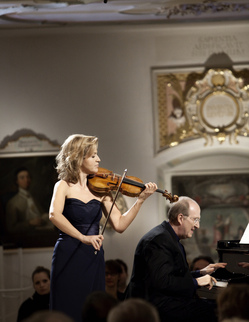
Anne-Sophie Mutter publicity photo
But you know, violinist Anne-Sophie Mutter and pianist Lambert Orkis, who played a dazzling recital Thursday evening at Hill Auditorium under University Musical Society auspices, are a cool pair, the model of grace and unruffled calm under pressure. No histrionics, no over-emoting. And certainly no sweating. It’s a beautiful thing to see.
And to hear, of course. Especially in a recital like Thursday’s, which was truly a duo recital. Mutter had top billing, of course, but in this program of Mozart, Schubert, Lutoslawski and Saint-Saens, Orkis had his work cut out for him as much as Mutter did.
And he was extraordinary, remarkable for his close-to-the-keys speed, clarity, color and drama. And the pair’s long recital partnership (and recording partnership) showed in the sympathetic musical dialog the two shared on stage. They played like two hands of the same person, the one complementing the other.
The evening’s pleasures were various, each piece engrossing while shining a different light on the violin and piano repertoire.
In the how many notes can dance on the head of a pin category, the Saint-Saens was perhaps the hands-down winner, but beyond effervescence, Mutter also wooed with sweet, silky tone and vocally expressive sighs, and Orkis sparkled in Saint-Saens’ star-kissed piano writing.
As in the Saint-Saens, the pair drove the Schubert Fantasy in C Major, D. 934, to a brilliant and thrilling finish (it was standing ovation time for the audience). But it’s the theme and variations based on Schubert’s song “Sei mir gegrusst” that are the heart of the work; in Mutter and Orkis’ hands, the variations succeeded each other in a sort of strophic alternation of instruments and moods, now songful, now tender, now frilly, now playful. And finally, luminous, tremulous, radiant.
Theme and variations introduced themselves early in the concert, in the Mozart Sonata No. 27 for Violin and Piano, K. 378, with which Mutter and Orkis opened. The playing here was intimate - of the sort you have to lean forward to catch - but it was not shy. Mutter’s tone, here more than elsewhere, had enough edge to convey the drama that ensues when Mozart turns the lights off in darker episodes; Orkis, meanwhile exploited register at the piano to equally fine dramatic effect.
To open the concert’s second half there was Lutoslawski’s “Partita,” a work dear to Mutter, for whom the composer made a version for violin and orchestra. It was unarguably the thorniest work on the bill, but with Mutter and Orkis as advocates, it pricked not at all. They made such fine sense of its nervous musical gestures, of now-me, now-you provocations, of its ostinato figures and its allusions to a world outside—birdsong, hunting calls—that you stayed with them, and the music, all the way.
The pair ended the evening on a sinuous note, with Ravel’s “Piece en forme de Habanera.”